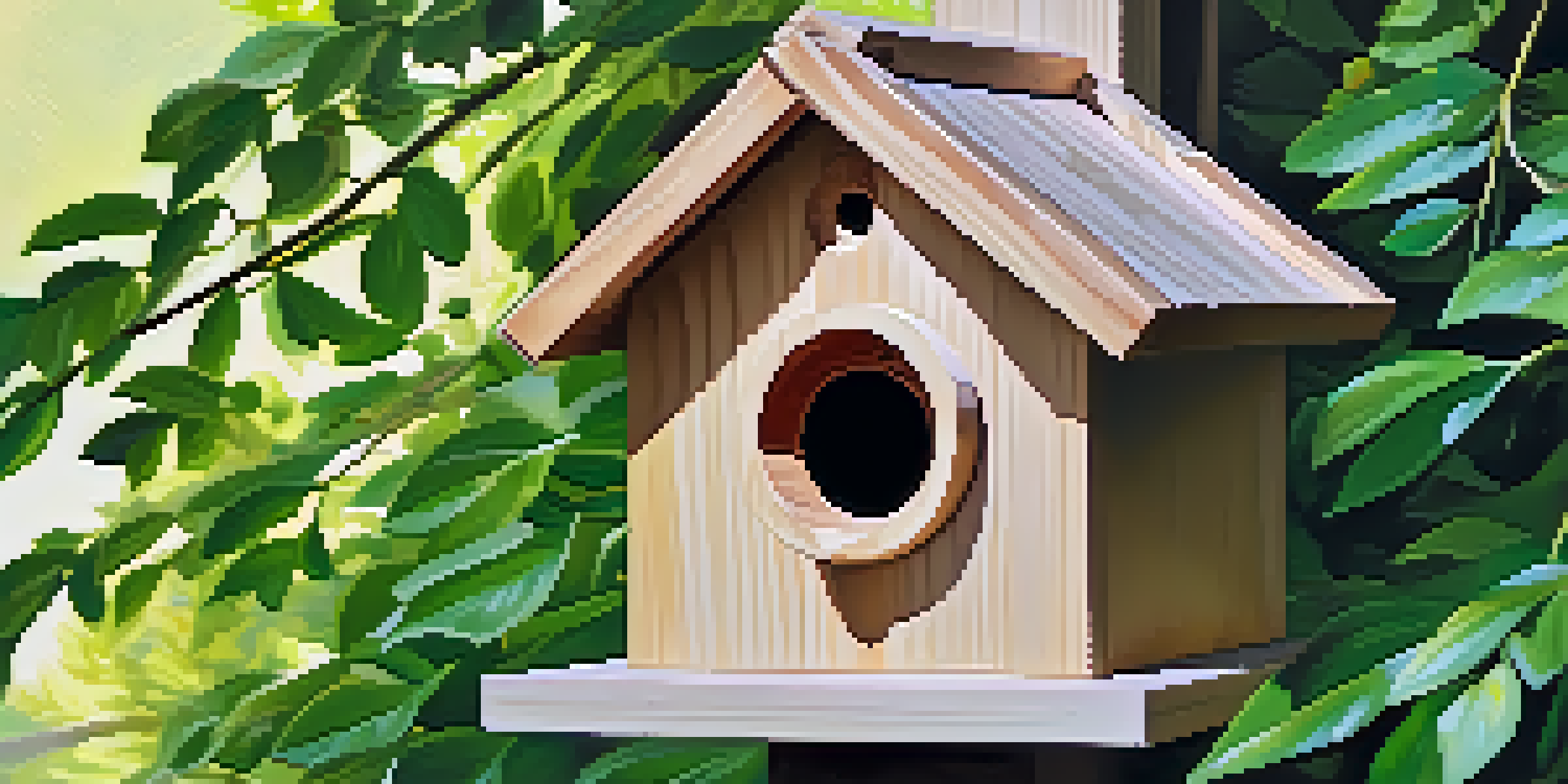Common Mistakes in Birdhouse Building and How to Avoid Them

Ignoring Proper Ventilation and Drainage
One of the most common mistakes when building birdhouses is overlooking proper ventilation and drainage. Without adequate ventilation, the interior can become too hot, especially during warmer months, creating an uncomfortable environment for nesting birds. Similarly, a lack of drainage can lead to water pooling inside, which not only deters birds but can also promote mold growth.
The bird is powered by its own life and by its motivation.
To avoid this, incorporate small holes near the roof for airflow and drainage holes at the bottom. These features will help maintain a healthy environment inside the birdhouse. Think of it as creating a cozy room with windows and a way for rainwater to escape; it makes all the difference!
By ensuring your birdhouse is well-ventilated and has proper drainage, you're not just building a shelter; you're providing a safe haven for birds to thrive.
Using the Wrong Materials for Construction
Choosing the right materials is crucial when building a birdhouse. Many novice builders might opt for treated wood or materials that emit harmful chemicals, which can be detrimental to birds. For example, pressure-treated wood contains chemicals that can leach into the environment, posing health risks to our feathered friends.

Instead, stick to untreated wood like cedar or pine. These materials are not only safe but also durable and weather-resistant. Imagine building a home that not only looks good but is also safe and snug—this is what the right materials can achieve!
Ensure Proper Ventilation and Drainage
Incorporating ventilation and drainage features in your birdhouse is essential for maintaining a healthy environment for nesting birds.
By selecting safe materials, you’ll ensure that your birdhouse is a sanctuary, allowing birds to feel secure and protected from the elements.
Failing to Consider the Size and Entry Hole Dimensions
Another common pitfall in birdhouse construction is not paying attention to the size and dimensions of the entry hole. Each bird species has specific requirements for entry hole size, and using the wrong measurements can keep birds from using your house altogether. For instance, a hole that's too large could invite larger, more aggressive birds or even predators.
In every walk with nature, one receives far more than he seeks.
To avoid this mistake, do a bit of research on the types of birds you want to attract and tailor your designs accordingly. Think of it like crafting a key; the right dimensions are essential for unlocking the door to a perfect home for your avian guests!
By carefully considering the size and entry hole dimensions, you'll create a welcoming space that encourages nesting and habitation.
Neglecting to Place the Birdhouse in the Right Location
Where you place your birdhouse can make or break its success. A common error is positioning the birdhouse in an area that is too exposed to harsh weather, predators, or human activity. Birds prefer quiet, sheltered spots where they feel safe and can easily access food and water.
To avoid this mistake, look for a location that offers a good balance of sunlight and shade, away from heavy foot traffic or busy roads. Consider it a prime real estate decision; just as we value peace and quiet, birds do too!
Choose Safe, Durable Materials
Using untreated wood, like cedar or pine, ensures that your birdhouse is a safe and durable sanctuary for birds.
By selecting an optimal location, you’ll increase the chances of attracting birds and ensuring they return season after season.
Overlooking Predation Risks in Birdhouse Design
One mistake that many builders overlook is the risk of predation. If your birdhouse design doesn't account for potential predators, it can become a target for raccoons, cats, or even snakes. Ensuring the safety of the birds should be a top priority, and a poorly designed birdhouse can leave them vulnerable.
To mitigate these risks, consider features like predator guards or placing the birdhouse in areas that are less accessible to potential threats. It’s a bit like fortifying a castle; you want to create a safe haven for your inhabitants.
By taking predation risks into account, you'll enhance the safety of your feathered friends and foster a thriving bird community.
Using Inappropriate Roof Styles and Overhangs
The style of the roof and the presence of overhangs can significantly affect the functionality of a birdhouse. Many builders may choose a roof style that doesn’t provide enough coverage or protection from the elements. A flat roof can collect rainwater, while a roof without an overhang can expose the entrance to harsh weather.
To avoid this mistake, opt for sloped roofs that allow rain to run off, and consider adding overhangs for extra protection. Think of the roof as an umbrella; it should keep the interior dry while allowing for airflow.
Position Birdhouse in Safe Locations
Selecting an optimal location for your birdhouse helps protect it from predators and harsh weather, increasing its chances of success.
By designing a birdhouse with the right roof style and overhangs, you'll create a comfortable and inviting space for birds to call home.
Neglecting Maintenance and Seasonal Care
Many birdhouse builders forget that maintenance is key to ensuring long-term use. Over time, birdhouses can accumulate dirt, moss, or even insect infestations, which can drive birds away. Regular maintenance is essential to keep the birdhouse clean and functional.
Make it a habit to check your birdhouse at the end of the nesting season and clean it out. Think of it as giving your feathered friends a spring cleaning; a refreshed space will be much more inviting for returning birds.

By committing to regular maintenance, you’ll not only keep your birdhouse in good shape but also foster a welcoming environment for new avian visitors year after year.